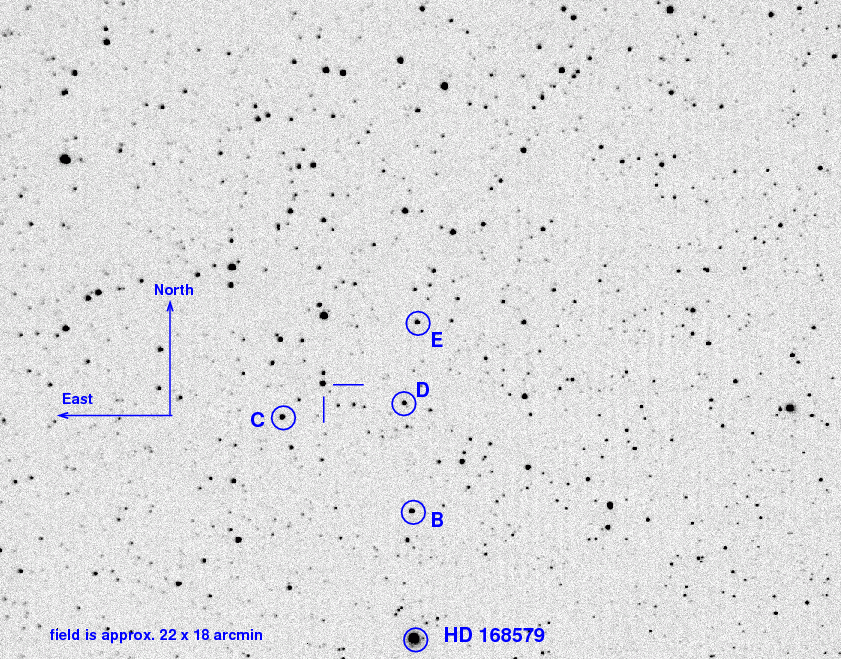
On the night of May 25/26, 2018, from about midnight to dawn, I acquired a set of observations of the likely black-hole system MAXIJ1820+070, (also known as ASASSN-18ey ).
The main setup was:
Notes from the night:
This optical and X-ray and radio transient is likely a black hole accreting material at a higher-than-usual rate. It has been the subject of many observers over the past two weeks -- see the trail of telegrams that include
The object is located at
RA = 18:20:21.9 Dec = +07:11:07.3
A chart of the field is shown below. The size of the chart is about 22 by 18 arcminutes.
I've marked the location of several comparison stars, which also appear in light curves below. Stars C, D, and E are mentioned by the Tomoe Gozen team in ATel 11426, but all three are rather red, with (B-V) ranging from 1.14 to 1.37. Star B is one of the bluest nearby bright stars, with (B-V) = 0.52.
star UCAC4 B V ---------------------------------------------------- B 486-079513 12.975 12.454 C 486-079608 13.968 12.830 D 486-079523 14.637 13.272 E 487-077858 14.637 13.272 ----------------------------------------------------
The dark current was higher than usual, since I was working at -17 C.

The sky value shows mostly clear early, then clouds growing before dawn.

Here's a record of the telescope's drift. Note the two jumps early, when I made two adjustments to the mount's altitude axis. First, I let the telescope track for a bit at its initial position (duct tape marks the knob's position); then, I twisted the knob by one notch clockwise, let it track for a while, then twisted the knob by one notch clockwise again. As you can see, the Dec drift decreased after each adjustment. Good! More adjustments on the next night.
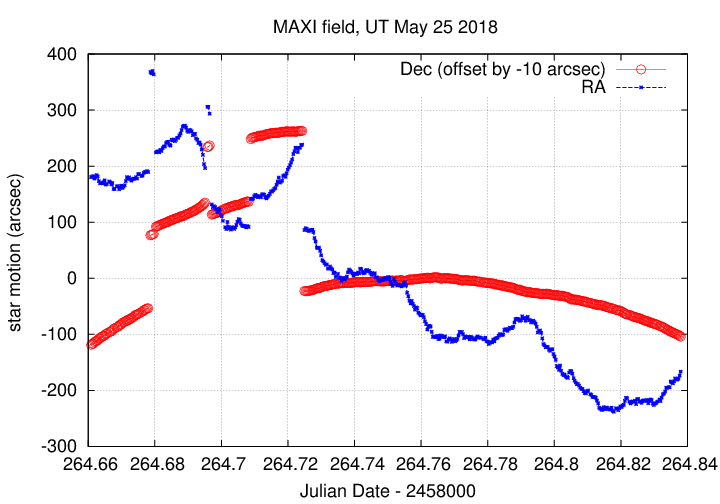
The number of objects detected.
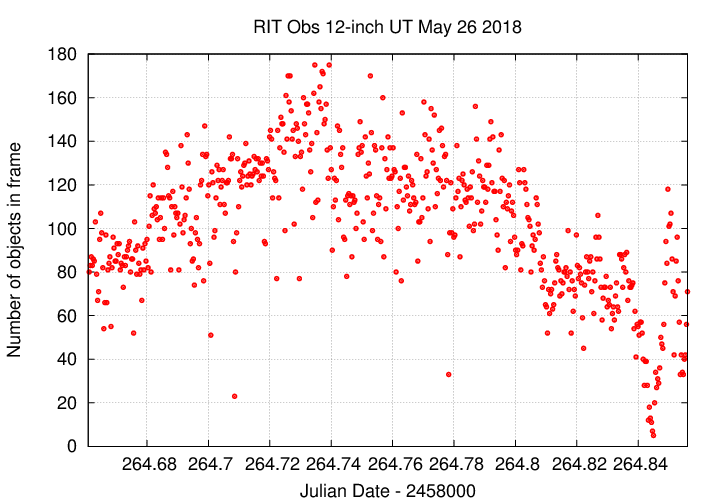
I used an aperture with radius 5.0 pixels.

Image adjustment factor shows brief clouds in the middle, then clouds at end.
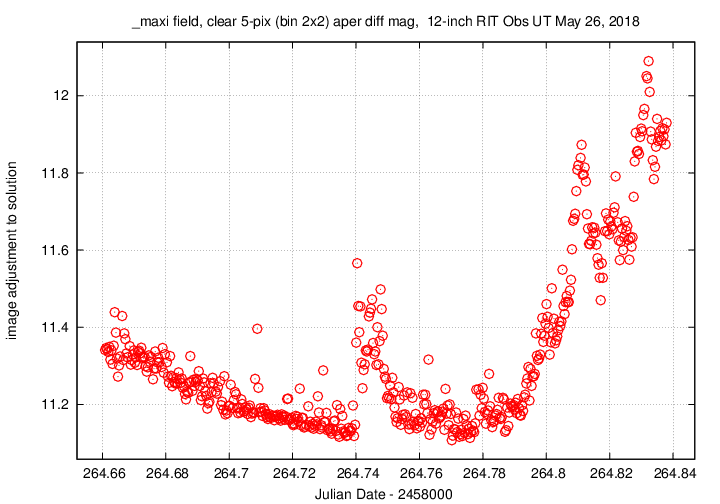
Using aperture photometry with a radius of 5 pixels (binned 2x2, each pixel is 1.34 arcsec, so a radius of 6.7 arcsec), I measured the instrumental magnitudes of a number of reference stars and the target. Following the procedures outlined by Kent Honeycutt's article on inhomogeneous ensemble photometry, I used all stars available in each image to define a reference frame, and measured each star against this frame.
Sigma-vs-mag plots show that the floor was about 0.005 mag overall (nice!). The outlier around instrumental magnitude 2.2 is MAXI J1820+070.

Here are light curves of the variable and the field stars. I was able to go back to the usual bright star as "A", because it wasn't saturated at 2x2 binning.
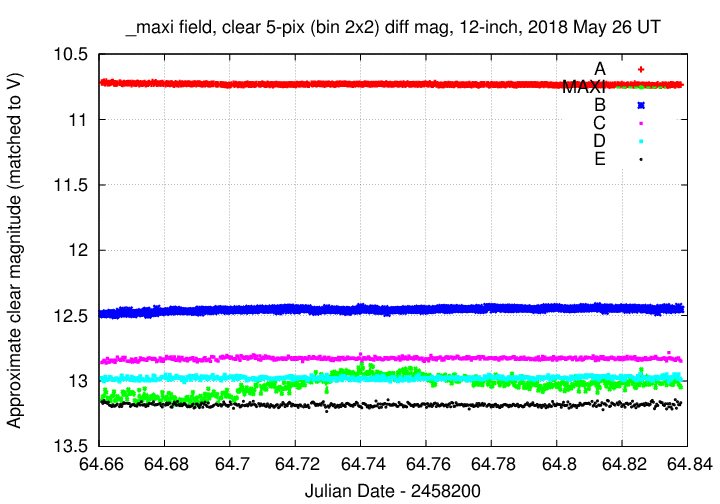
I used the UCAC value for the V-band magnitude of star "B" = UCAC4 486-079513 to shift the ensemble magnitudes to the standard V-band scale -- but remember that these are UNFILTERED measurements.
Here's a closeup on the variable. I'll connect the dots to make its behavior a bit easier to see.
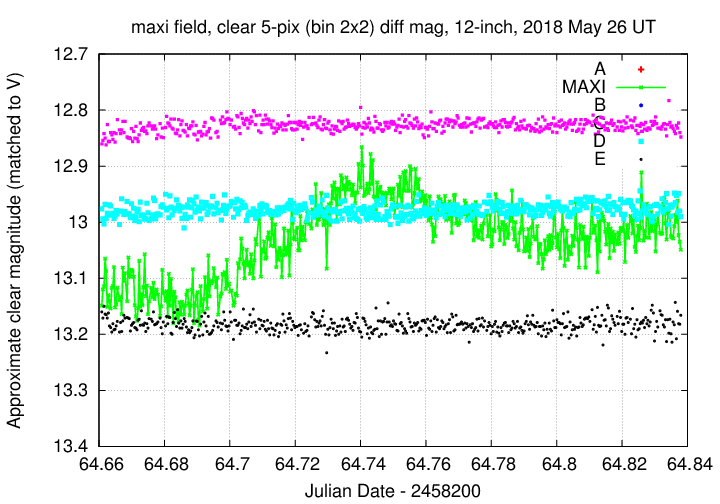
You can download my measurements below. A copy of the header of the file is shown to explain the format.
# Measurements of MAXIJ1820+070 made at RIT Obs, UT 2018 May 26, # in fair conditions, # by Michael Richmond, # using Meade 12-inch LX200 and ATIK 11000. # Exposures 25 seconds long, no filter. # Tabulated times are midexposure (FITS header time - half exposure length) # and accurate only to +/- 1 second (??). # 'mag' is a differential magnitude based on ensemble photometry # using a circular aperture of radius 5 pix = 6.7 arcseconds. # which has been shifted so UCAC4 486-079513 has mag=12.454 # which is its V-band magnitude according to UCAC4. # # UT_day JD HJD mag uncert May26.16086 2458264.66086 2458264.66517 13.149 0.013 May26.16120 2458264.66120 2458264.66551 13.120 0.012 May26.16154 2458264.66154 2458264.66585 13.114 0.013
Last modified 5/26/2018 by MWR.